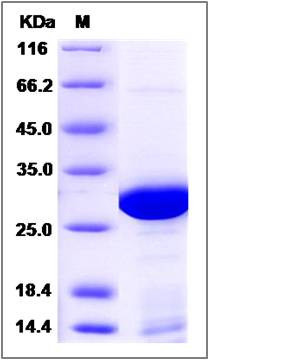Human PA28A / PSME1 Protein (His Tag)
IFI5111,PA28A,PA28alpha,REGalpha
- 100ug (NPP4139) Please inquiry
| Catalog Number | P14654-H07E |
|---|---|
| Organism Species | Human |
| Host | E. coli |
| Synonyms | IFI5111,PA28A,PA28alpha,REGalpha |
| Molecular Weight | The recombinant human PSME1 consists of 264 amino acids and predicts a molecular mass of 30.6 KDa. It migrates as an approximately 28-32 KDa band in SDS-PAGE under reducing conditions. |
| predicted N | His |
| SDS-PAGE |  |
| Purity | > 90 % as determined by SDS-PAGE |
| Protein Construction | A DNA sequence encoding the human PSME1 (Q06323) (Met1-Tyr249) was expressed with a polyhistidine tag at the N-terminus. |
| Bio-activity | |
| Research Area | Cell Biology |Cell Cycle |other in cell cycle |Ubiquitin-Proteasome Pathway |Proteasome |
| Formulation | Lyophilized from sterile 50mM Tris, 100mM NaCl, 10% Glycerol, pH 8.0. 1. Normally 5 % - 8 % trehalose and mannitol are added as protectants before lyophilization. Specific concentrations are included in the hardcopy of COA. |
| Background | PA28A, also known as PSME1, is a subunit of proteasome. The 26S proteasome multicatalytic proteinase complex has a highly ordered structure composed of 2 complexes, a 20S core and a 19S regulator. The 20S core is composed of 4 rings of 28 non-identical subunits; 2 rings are composed of 7 alpha subunits and 2 rings are composed of 7 beta subunits. The 19S regulator is composed of a base, which contains 6 ATPase subunits and 2 non-ATPase subunits, and a lid, which contains up to 10 non-ATPase subunits. Proteasomes are distributed throughout eukaryotic cells at a high concentration and cleave peptides in an ATP/ubiquitin-dependent process in a non-lysosomal pathway. An essential function of a modified proteasome, the immunoproteasome, is the processing of class I MHC peptides. The immunoproteasome contains an alternate regulator, referred to as the 11S regulator or PA28, that replaces the 19S regulator. Three subunits (alpha, beta and gamma) of the 11S regulator have been identified. PSME1 gene encodes the alpha subunit of the 11S regulator, one of the two 11S subunits that is induced by gamma-interferon. Three alpha and three beta subunits combine to form a heterohexameric ring. |
| Reference |
